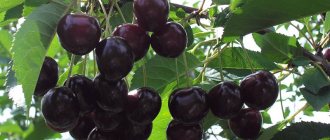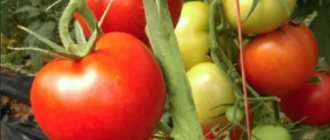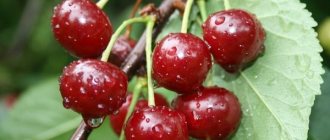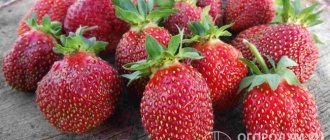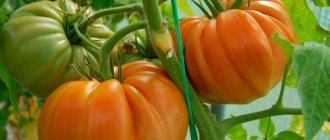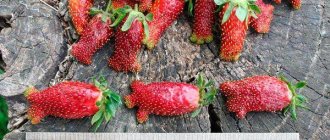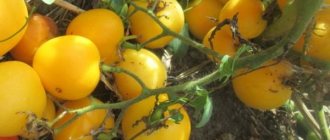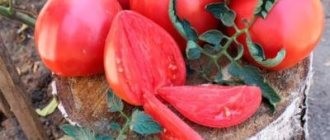Description of the Krasa Severa cherry variety and characteristics of the fruit and tree, cultivation
The summer resident dreams of planting a tree that meets all the requirements put forward. Successful cultivation requires a lot of attention to studying information about the species. The Krasa Severa cherry has a positive reputation. Summer residents value it for its positive qualities, including high frost resistance, immunity and more.
Description of the variety
The hybrid of cherries and cherries Krasa Severa was obtained by breeders a long time ago, but still does not lose authority and recognition among gardeners. Back in 1885, a cherry seedling was fertilized with cherry pollen. At first it bore white fruits, but gradually the color changed and the cherries turned pink.
The description of the variety shows that the tree is very hardy. The only condition for its effective cultivation is fertile soil. Without this, productivity is significantly reduced.
Characteristics
For proper cultivation, you should study the characteristics. Sometimes gardeners, out of ignorance, make unforgivable mistakes when planning or caring for a young tree. As a result, part of the harvest is lost.
Winter hardiness
The variety is suitable for growing in areas with harsh winters. Excellent frost resistance allows you to grow the tree without fear. But in regions with low temperatures down to –35 ⁰C, gardeners prefer to additionally wrap the trees for the winter.
The tree itself and the fruit buds are resistant to frost. Flowers can withstand returning spring frosts.
Fruit
Unusual berries are large and very tasty, they have the following characteristics:
- pink colour;
- shape: round;
- skin: elastic, smooth;
- the taste is sweet with a slight sour aftertaste;
- weight 8 g;
- diameter 30 mm;
- light juice.
Due to their appearance, the fruits are not touched by birds.
Tree dimensions
The height of the plant does not exceed 3 m. The crown is wide and spreading. The characteristics of the tree make it possible to use Krasa Severa cherry for decorating a garden or other areas. The leaves on the tree are large. They have features that make it easy to distinguish this species from other varieties even at a young age:
- leaf plate length 14 cm, width 9 cm;
- color dark green, matte;
- leaf-noses are red in color and have warty protrusions.
In conditions of sufficient heat supply, the tree does not grow vigorously, which greatly facilitates the process of care and harvesting.
Timing of flowering and fruit ripening
It blooms early, abundantly and is not afraid of return frosts. In the first ten days of July, the first cherries are harvested. The berries ripen smoothly and consistently every year. There are no breaks.
The yield is high, approximately 15-20 kg per tree, depending on the care and efforts of the gardener.
Disease resistance
The immunity to diseases of the Krasa Severa cherry is average. If you carry out preventive treatments, then the tree is not afraid of either viruses or fungi. This must be done in spring and autumn.
Treated with chemicals before flowering. Then they use traditional methods of fighting diseases. This way the fruits remain environmentally friendly and harmless to human health.
Rules for planting and care
To grow a decent harvest, you need to plant the tree correctly. For planting, choose a sunny place, preferably protected from drafts.
Cherries do not like stagnant water, so they do not allocate a plot in the lowlands. The hole is dug in advance in the fall if planting is planned in the spring. The soil for filling is mixed with humus, a little sand and mineral fertilizers are added. Mix everything well. The seedling is planted along the root collar. Sprinkle with the prepared soil mixture and water well.
Further watering is carried out once every week or two. Depending on how rainy the period turns out to be. After the soil dries a little, loosen the tree trunk circle. This will provide oxygen and retain moisture in the soil. Feeding is carried out systematically 2-3 times per season.
Gardeners whose region of residence has a harsh climate should plant Krasa Severa cherries on their plot. The tree withstands severe frosts and produces a harvest every year.
Characteristics
For proper cultivation, you should study the characteristics. Sometimes gardeners, out of ignorance, make unforgivable mistakes when planning or caring for a young tree. As a result, part of the harvest is lost.
Winter hardiness
The variety is suitable for growing in areas with harsh winters. Excellent frost resistance allows you to grow the tree without fear. But in regions with low temperatures down to –35 ⁰C, gardeners prefer to additionally wrap the trees for the winter.
The tree itself and the fruit buds are resistant to frost. Flowers can withstand returning spring frosts.
Fruit
Unusual berries are large and very tasty, they have the following characteristics:
- pink colour;
- shape: round;
- skin: elastic, smooth;
- the taste is sweet with a slight sour aftertaste;
- weight 8 g;
- diameter 30 mm;
- light juice.
Due to their appearance, the fruits are not touched by birds.
Tree dimensions
The height of the plant does not exceed 3 m. The crown is wide and spreading. The characteristics of the tree make it possible to use Krasa Severa cherry for decorating a garden or other areas. The leaves on the tree are large. They have features that make it easy to distinguish this species from other varieties even at a young age:
- leaf plate length 14 cm, width 9 cm;
- color dark green, matte;
- leaf-noses are red in color and have warty protrusions.
See also
When does it ripen and how to pick cherries correctly, characteristics of varieties and regionsRead
In conditions of sufficient heat supply, the tree does not grow vigorously, which greatly facilitates the process of care and harvesting.
Timing of flowering and fruit ripening
It blooms early, abundantly and is not afraid of return frosts. In the first ten days of July, the first cherries are harvested. The berries ripen smoothly and consistently every year. There are no breaks.
The yield is high, approximately 15-20 kg per tree, depending on the care and efforts of the gardener.
Disease resistance
The immunity to diseases of the Krasa Severa cherry is average. If you carry out preventive treatments, then the tree is not afraid of either viruses or fungi. This must be done in spring and autumn.
Treated with chemicals before flowering. Then they use traditional methods of fighting diseases. This way the fruits remain environmentally friendly and harmless to human health.
Cherry Beauty of the North: description of the variety and characteristics of the tree and fruit, cultivation
Entry of the variety into fruiting, year
Detailed description of Duke of the Krasa Severa variety: large size, juicy, light pink fruits weighing up to 8 g, early ripening, with a pleasant taste, resistant to...
Features of planting and growing.
1. Choosing a place for cherries.
– Cherries require a well-lit place. Otherwise, a decrease in the sugar content of the fruit and a general decrease in yield are possible.
– Cherry is far from the most frost-resistant crop. In this regard, it is recommended to plant next to country houses (between a barn and a bathhouse, a house and a fence). The best place for cherries is sunny, covered on the north side by a brick wall, which, when heated, will not only protect from cold winds, but also damage the tree.
– Cherries do not tolerate stagnant water. If there is a possibility of flooding on the site, the tree should be drained if possible or planted on a hill. Otherwise, the tree will have poor development or even death. The groundwater level should be at least 1.5-2 m.
– Cherries grow best on light sandy or loamy soils. On heavy clay or sandy soil, cherries most likely will not grow. In this case, a good landing hole is required. The acidity of the soil should be close to neutral: pH 6.5-7.0.
2. Cherry planting and care.
– Planting of seedlings can be carried out exclusively in the spring (for bare root plants), and from spring to October (for containerized plants).
– Cherry seedlings should not be buried when planted in the ground. The root collar (the place where the root enters the trunk) should be 5-7 cm above ground level.
– When buying a seedling in the spring, you can immediately prune the branches. You can't cut the roots. The more of them a young tree has, the faster it will take root. The roots can only be straightened.
– Almost all varieties of cherries growing in the Moscow region are considered self-sterile, that is, they need pollen from another plant to set fruit. Accordingly, you should keep this in mind and if you or your neighboring plot does not have another tree (another variety of cherry), you should purchase it immediately. Even in self-fertile varieties, yields increase significantly when a pollinator appears. There is also an opinion that although cherries and cherries practically do not cross-pollinate, they have a beneficial effect on each other.
– The feeding area of one cherry tree is about 12 sq.m.
– When planting cherries, either organic fertilizer (horse humus or humus), potassium chloride - 20 g, superphosphate 30-40 g are placed in the planting hole.
Further feeding. Nitrogen fertilizers, for example urea (200 g), are applied to the tree trunk circle in early spring, followed by watering; at the end of July-September, superphosphate (350 g) and potassium sulfate (100 g) are poured. Subsequently, organic fertilizers are applied in late autumn and early spring.
Best Cherry Varieties for the Northwest
The weather in the western region is variable. Summers can be hot, but with a lot of rain. But winter is characterized by changeable weather.
There may be both cold, snowy winters and years when there is minimal snowfall and thaws are replaced by sharp cold snaps. The latter is especially dangerous for trees, since without snow and sudden temperature changes there is a danger of cherries freezing.
That is why, when choosing fruit crops, a gardener must, first of all, pay attention to the frost resistance indicators of cherries and their zoning for the north-west.
Today, breeders have developed dozens of varieties of cherries that can easily withstand frequent temperature changes in winter, have good frost resistance, and allow summer residents to obtain a tasty harvest. We bring you the best cherries for the northwest.
Cherry Beauty of the North
Cherries of the Krasa Severa variety are very popular among gardeners in the western region. This variety was bred by the famous breeder Michurin, and is distinguished by good yield, frost resistance and good taste characteristics of the grown crop.
It is also necessary to note the excellent decorative properties of such cherry trees, which allows us to consider them as a good option for decorating the garden and local area.
One of the features of this variety is the large-fruited harvest. Typically, the average weight of such cherry fruits of the Krasa Severa variety reaches 8 grams. The pulp has a dessert refreshing taste.
We also note the early ripeness of this variety, so the harvest is carried out in early July. Among the features, we can also note the fact that the fruits hold tightly to the branches, do not fall off for a long time, and at the same time, the crop itself is rarely attacked by birds.
We also note the good resistance of this variety to fungal infections. The best cherry varieties for the northwest will allow all gardeners, without exception, to get a harvest.
In the northern regions, the height of the Beauty of the North cherry usually does not exceed three meters. But when grown in a warm climate, the cherry tree becomes smaller and becomes dwarf.
Let us note the ease of caring for such cherries, which will require the gardener to prune in the spring, water and apply organic fertilizers in preparation for winter.
Also remember that it is recommended to additionally insulate the plantings before the onset of cold weather, which will eliminate the danger of trees freezing.
The best varieties of cherries
Amorel early
Amorel early. A winter-hardy variety that can produce a harvest two years after planting. Pulp with a sweet delicate taste. It is a table variety and is usually harvested in July.
The variety is self-fertile, and it shows its best performance in the presence of pollinators in the immediate vicinity, of which we recommend other cherries. Early amorel is characterized by resistance to fungus, bears fruit well and is easy to care for.
Vladimirskaya
Vladimirskaya is an old variety that enjoys well-deserved love among domestic gardeners. It has good winter hardiness, which makes it possible to successfully grow such cherries in the northwestern region.
Vladimir cherry can grow as a tree or medium-sized bush. Fruiting usually begins by five years, and in bush varieties by three years after planting.
Vladimirskaya cherry quickly gains productivity and bears fruit for up to 30 - 40 years. A gardener will be able to get about 20 kilograms from a tree. The Vladimir cherry berries themselves are large, weighing about 4 grams.
Harvesting begins in August. Remember that the fruits quickly fall off after ripening, so you should not delay harvesting. The variety is self-sterile, and the best pollinators for it are Lyubskaya or Korostynskaya.
Lyubskaya
Lyubskaya is another popular variety in the northwest. Trees of this variety are compact in size with a height of 2.5 meters. This is a fast-growing and extremely productive variety. However, when grown in the north, it will necessarily require appropriate insulation.
The gardener can receive the first fruits within two years after planting the seedlings. The berries themselves are large in size. Harvest ripening begins in August.
In this case, the harvest can be extended over several weeks without fear of deterioration in the taste of the ripened fruits. This is a self-fertile variety, so it can be planted at a distance from other trees.
Korostynskaya
We can also recommend paying attention to the Korostynskaya variety, which is easy to care for and allows you to get a good harvest. This variety is characterized by abundant yield, it is durable and has high frost resistance.
Fruiting usually begins in the fifth year after planting. The fruits are medium-sized, rarely exceeding 3 grams in weight. At the same time, you can get about 20 kilograms of berries from one harvest. The variety belongs to the category of partially self-fertile. Among the best pollinators we recommend Vladimirskaya cherry and Griot Ostheim.
Self-fertile varieties for the northwest
All cherry varieties can be divided into two categories: self-fertile and self-fertile. The latter are able to produce crops even when planted at a distance from other pollinators.
This allows you to better plan the location of plantings in your garden, and the gardener is freed from any problems with cross-pollination. Among the popular varieties of self-fertile varieties for the north-west we can find the following:
Ruby
Ruby is a hybrid of steppe cherry, which is characterized by a branched, low-growing crown and good frost resistance. Fruiting of this cherry begins in the fifth year, and the gardener receives a good harvest.
The fruits are large in size, with characteristic yellow flesh. The harvest ripens in early August. This is a self-sterile variety that can be planted on the site without any additional pollinators.
Sadovaya
Sadovaya is another popular variety of European selection, which, due to its good frost resistance, has become widespread in the northwestern region. Medium-sized trees with a sparse spreading crown.
The fruits are large, weighing about 5 grams. The berries have a distinct heart-shaped shape. The pulp is extremely tasty and sweet. Ripening later, with abundant yield.
Amorel Nikiforova
Amorel Nikiforova. This is a variety of folk selection that has a medium-sized tree with a spreading crown. A frost-resistant and productive variety, it has fruits with a size of no more than 3 grams.
Fruiting begins in the fourth year, and harvesting begins at the end of July. This is a partially self-fertile variety that can be planted either near pollinators or at a distance from other fruit trees.
sadovodya.ru
Duke Krasa Severa (cherry-cherry hybrid)
(variety description, photo)
Early ripening, the fruits are very large - up to 8 g!, pink, smooth, the flesh is very juicy with a rich cherry aroma, sweet with a refreshing sourness
Description of the variety:
A unique berry - a miracle cherry for Siberia. Combines the frost resistance of cherries and the sweet, unique taste of cherries.
Early maturity - ripening occurs in mid-July. The fruits are very large, up to 8 g!, with a beautiful rounded shape. The color is light pink. The pulp is very juicy, dense, crispy, pleasant in texture, with uncolored light juice and a rich cherry aroma. The taste is sweet, very bright, with a slight pleasant sourness, the stone is small and easily separated. Ripening is early and friendly, while the fruits stay firmly on the tree and are not attacked by birds. The variety is self-sterile (early flowering cherries are suitable for pollination), begins to bear fruit quite early, 3-4 years after planting. One of the most productive and frost-resistant varieties (-30ºС). Duke Krasa of the North is incredibly hardy! The wood does not suffer from winter frosts, is not subject to gum development, the flowers tolerate spring frosts well, as a result of which the variety’s annual yield is high. Highly resistant to major diseases, prefers fertile neutral soils. The trees are medium-sized (3 m), with a pyramidal crown.
How to buy seedlings of Duke Krasa Severa (a hybrid of cherry and sweet cherries) at the Siberian Garden nursery
In our nursery, you can buy seedlings of Duke Krasa Severa (a hybrid of cherry and sweet cherries) on open trading floors and in nursery stores. For addresses, opening hours, and phone numbers of retail outlets, see the “Contacts” (in the top menu).
Duke Beauty of the North
A very old, time-tested variety. Cherry varieties Bel and Winkler were chosen as parents. The authorship belongs to I.V. Michurin himself. It was assumed that the hybrid would be grown in Western Siberia. But the tree turned out to be not so winter-hardy, and the flower buds were partially damaged by Siberian frosts, so the yield was quite low.
Duke is famous for its very large, pale pink, onion-shaped fruits with yellowish, juicy, sweet, dense pulp, which ripen closer to mid-summer. Ripe berries are able to patiently wait for harvest, holding tightly to the branches.
The Beauty of the North greets the third spring in its life with vigorous flowering. The self-sterility of the variety requires the presence of a pollinator to produce an ovary, so self-fertile cherries or sweet cherries should grow on the site. In this case, the cherry tree will annually provide generous harvests.
Characteristic features of the tree:
• average height (about 5-6 meters); • reverse pyramidal crown; • powerful, thick skeletal branches of gray color with a brownish tint; • lack of tendency to increased shoot formation; • large, glossy, dark green, oval-shaped leaves with a narrow, sharp tip and finely toothed edges.
The truly Siberian health of the Cherry Krasa Severa allows you to do without preventive spraying with fungicides. She does not get sick and is practically not affected by pests. The tree has high drought resistance and good winter hardiness. Light loam with neutral acidity will be an ideal growing soil. When planting, humus is added to the sandy loam soil, and the acidity is adjusted by adding lime. An important condition is that the area should not be swampy, groundwater should be as low as possible. The formation of the crown is completed when the tree is four years old; in subsequent years, sanitary pruning and, if necessary, thinning pruning are carried out in early spring. Whitewashing the trunk with lime and loosening the tree trunk in late autumn is mandatory to protect the tree from frost, burns and pests that wish to spend the winter nearby.
• average height; • low maintenance; • lack of tendency to shoot formation; • good health and good immunity; • resistance to pests; • early pregnancy; • large fruit; • very tasty berries; • regularity of fruiting; • high productivity; • winter hardiness; • drought resistance.
There is only one drawback - self-sterility. It is usually difficult to notice if you manage to choose the right pollinator variety.
Beauty of the North cherry variety description
Description of the Cherry Variety Beauty of the North.
Description of the Cherry Variety Beauty of the North
The Beauty of the North cherry is also interesting. This is a hybrid variety. It has good winter hardiness and a beautiful pale pink color. Hence the name of the tree - Beauty of the North. Cherry fruits are large - their weight reaches 8 grams. The pulp has a sweet-sourish refreshing taste. Cherries ripen early - in the first half of June. And one more feature - the fruits hold tightly to the branches and are less likely than other varieties to be attacked by birds.
In its homeland, in the northern regions of the country, this cherry reaches 2.5-3 meters. But in Odessa it did not rise above 1.2 meters - it turned into a dwarf tree.
From the very beginning of working in the garden, I decided to grow these particular trees: they take up much less space, caring for them is not very labor-intensive, and the harvest can be considered satisfactory.
But it was one thing to decide, and another to implement: seedlings and seeds of dwarf trees were difficult to find. That’s why we had to pave the way to Michurinsk.
Duke Beauty of the North
A very old, time-tested variety. Cherry varieties Bel and Winkler were chosen as parents. The authorship belongs to I.V. Michurin himself. It was assumed that the hybrid would be grown in Western Siberia. But the tree turned out to be not so winter-hardy, and the flower buds were partially damaged by Siberian frosts, so the yield was quite low.
Duke is famous for its very large, pale pink, onion-shaped fruits with yellowish, juicy, sweet, dense pulp, which ripen closer to mid-summer. Ripe berries are able to patiently wait for harvest, holding tightly to the branches.
The Beauty of the North greets the third spring in its life with vigorous flowering. The self-sterility of the variety requires the presence of a pollinator to produce an ovary, so self-fertile cherries or sweet cherries should grow on the site. In this case, the cherry tree will annually provide generous harvests.
Characteristic features of the tree:
• average height (about 5-6 meters);
• reverse pyramidal crown; • powerful, thick skeletal branches of gray color with a brownish tint; • lack of tendency to increased shoot formation; • large, glossy, dark green, oval-shaped leaves with a narrow, sharp tip and finely toothed edges.
The truly Siberian health of the Cherry Krasa Severa allows you to do without preventive spraying with fungicides. She does not get sick and is practically not affected by pests. The tree has high drought resistance and good winter hardiness. Light loam with neutral acidity will be an ideal growing soil. When planting, humus is added to the sandy loam soil, and the acidity is adjusted by adding lime. An important condition is that the area should not be swampy, groundwater should be as low as possible. The formation of the crown is completed when the tree is four years old; in subsequent years, sanitary pruning and, if necessary, thinning pruning are carried out in early spring. Whitewashing the trunk with lime and loosening the tree trunk in late autumn is mandatory to protect the tree from frost, burns and pests that wish to spend the winter nearby.
• low maintenance; • lack of tendency to shoot formation; • good health and good immunity; • resistance to pests; • early pregnancy; • large fruit; • very tasty berries; • regularity of fruiting; • high productivity; • winter hardiness; • drought resistance.
There is only one drawback - self-sterility. It is usually difficult to notice if you manage to choose the right pollinator variety.
Best Cherry Varieties for the Northwest
The weather in the western region is variable. Summers can be hot, but with a lot of rain. But winter is characterized by changeable weather.
There may be both cold, snowy winters and years when there is minimal snowfall and thaws are replaced by sharp cold snaps. The latter is especially dangerous for trees, since without snow and sudden temperature changes there is a danger of cherries freezing.
That is why, when choosing fruit crops, a gardener must, first of all, pay attention to the frost resistance indicators of cherries and their zoning for the north-west.
Today, breeders have developed dozens of varieties of cherries that can easily withstand frequent temperature changes in winter, have good frost resistance, and allow summer residents to obtain a tasty harvest. We bring you the best cherries for the northwest.
Cherry Beauty of the North
Cherries of the Krasa Severa variety are very popular among gardeners in the western region. This variety was bred by the famous breeder Michurin, and is distinguished by good yield, frost resistance and good taste characteristics of the grown crop.
It is also necessary to note the excellent decorative properties of such cherry trees, which allows us to consider them as a good option for decorating the garden and local area.
The best varieties of frost-resistant cherries
To achieve success in growing crops, it is recommended to choose the most frost-resistant varieties.
Altai swallow
This plant is a bush that grows up to 1.5 meters. The plant has a dense and spreading crown. It requires systematic pruning. Otherwise, the crown will become too thick, which will lead to a decrease in yield. The fruits ripen at the end of June and are distinguished by their versatility.
Ashinskaya
This is one of the best varieties for the northern regions. It is a small bush no more than 1.5 meters high. The plant can withstand temperatures as low as -55 degrees. It is characterized by high resistance to dry weather. The fruits are dark in color and contain dense pulp with a sweet and sour taste.
Bagryannaya
This variety is suitable for cultivation in central Russia. It is able to withstand severe frosts and severe drought. The culture normally perceives daily temperature fluctuations and many diseases.
Biryusinka
This is a shrub that has spreading branches and a lush crown. The height of the plant is no more than 2 meters. It is characterized by dark green, oval-shaped leaves. During the season, cherries produce 20 kilograms of fruit. The variety is highly winter-hardy and practically not susceptible to infections and parasites.
Cherry Beauty of the North
This cherry variety is very popular among gardeners. It is characterized by excellent yield and high frost resistance.
The culture has excellent taste and excellent decorative properties.
The berries of this variety are characterized by large sizes. The average weight of the fruit reaches 8 grams. The pulp has a dessert-like, refreshing taste. The fruits ripen quite early. The harvest can be harvested already in the first half of July.
Vyanok
This plant grows up to 3 meters and has a slightly raised crown. It is characterized by a pyramidal shape. Ripe berries have a burgundy color and smooth skin. The pulp has a soft consistency and sour taste. With adequate care, cherries produce up to 20 kilograms of fruit.
See also
Description and characteristics of the Kharitonovskaya cherry variety, planting and care
Read
Dessert Volga
This crop is recommended to be grown in the Middle Volga region. It is highly resistant to frost and is suitable for cultivation in Siberia. Small trees produce a harvest for the 4th year of life. The variety is considered self-fertile.
Zarnitsa
This variety grows well in cold regions. It is almost not afraid of frost and easily tolerates a spring drop in temperature. Fruiting occurs 2-3 years after planting on a permanent site. The fruits are small in size and do not exceed 2 grams. The berries have a juicy and sweet taste, which is why they are often used to make jam and desserts.
Zarya Volga region
This cherry is characterized by a wide crown. The fruits appear 4 years after planting. The harvest should begin in early July. The fruits are large in size and weigh 4.2 grams. The peel has a dark red tint. The pulp is dark burgundy and very juicy. The bone comes off easily.
Lotovka
This is a late self-fertile variety that has excellent frost resistance. The tree does not suffer from gray rot. It is characterized by tasty fruits that stay on the tree for a long time and do not fall off. The berries reach 4-4.8 grams and have a sweet and sour taste.
Lyubskaya
This crop easily tolerates winter frosts and summer drought. She does not need systematic care. Even rare soil moisture does not affect the yield. The tree is considered self-fertile, and therefore does not need pollinators. The downside is weak immunity, which leads to the frequent occurrence of diseases.
The first harvest can be harvested in the first half of August. The berries are large in size and easily tolerate long-term storage and transportation. The plant should be grown exclusively in light soil.
Menzelinskaya
The culture tolerates frosts a little worse than others. However, its winter hardiness is above average. The plant easily tolerates drought and is highly resistant to fungal infections.
The variety is considered a self-sterile shrub that reaches 2.5 meters. It is characterized by a wide and spreading crown.
The fruits are round in shape and dark pink in color. They weigh 3 grams and have a sweet and sour taste. The bone is small in size and can be easily removed. At the same time, the yield is at an average level. Even from an adult plant you can get a maximum of 12 kilograms of fruit.
Morozovka
This variety is characterized by many positive properties. It has strong immunity and resistance to frost. The plant has early fruiting, juicy and sweet fruits. The berries can be used for making juices and canning. They are also eaten fresh. The fruits ripen in July. They are easy to transport.
Mtsenskaya
This tree rarely exceeds 2 meters. It is characterized by an oval crown. The fruits weigh 4 grams and have a dark burgundy skin. It is usually recommended to process the fruits.
The trees are highly resistant to frost or dry weather. They are also resistant to many diseases. Trees are characterized by an attractive appearance. That’s why they are often used in landscape design.
Novodvorskaya
The culture is a self-fertile hybrid that grows up to 2.5 meters. The crown is round. The leaves have a dark green color. Flowering begins in May and is characterized by moderate abundance. After its completion, large dark red fruits appear on the tree. They reach a weight of 5 grams.
Under the tough skin there is dense pulp with a small stone that is easily separated. The fruit has a sour taste. Most often they are used for culinary purposes.
The plant is characterized by average yield parameters. From an adult tree it is possible to obtain up to 15 kilograms of fruit. In addition to excellent resistance to frost, cherries of this variety easily resist fungal infections.
Ob
This is a low plant that reaches a height of 130 centimeters. It bears fruit on annual growths. The culture is characterized by small dark red fruits that have a good taste. The berries ripen in mid-July.
See also
Methods of propagating cherries by cuttings in summer, rules of agricultural technology
Read
Cherries of this variety easily tolerate severe frosts and dry weather. At the same time, it often suffers from attacks by pests. The variety is considered self-fertile and therefore does not require pollination.
Turgenevka
The plant reaches 3 meters. It is characterized by large heart-shaped berries that weigh up to 6.5 grams. The peel has a dark red hue and a sweet and sour taste. The first harvest can be obtained 5-6 years after planting. The fruits fully ripen in the first half of July.
Cherries of this variety tolerate winter frosts well. However, there is a risk of plant death in case of return frosts. The culture is characterized by high resistance to disease, but requires pollination. The variety is characterized by high stable yield.
Shpanka Shimskaya
This plant reaches 3-4 meters in height. It can withstand strong temperature drops. Therefore, the crop is often planted in areas with cold climates. The fruits have a sweet and sour taste and are large in size.
Annushka
This is a winter-hardy crop that is medium in size. It is characterized by large berries that reach 5 grams. They have a round shape and a dark red hue. The fruits have a pleasant sweet and sour taste. The crop can easily be transported. The fruits can be harvested in late June or early July.
The key advantage of the variety is self-fertility. However, experienced gardeners recommend planting cherries nearby. This will help increase yield parameters.
Student
The culture is characterized by a reverse pyramidal shape. The key advantage of the variety is good yield. The plant is valued for its resistance to frost. It quickly begins to bear fruit. At the same time, the berries have an excellent taste.
The plant has large fruits that weigh 4 grams. The berries are characterized by a rich burgundy hue.
The fruits are easily transported and do not lose their presentation. The plant bears fruit well 3 years after growing in open soil. Harvesting can be done in the second half of July.
The main disadvantage of the plant is considered to be self-sterility. Therefore, it is recommended to plant pollinators nearby. Suitable varieties for this include Zhukovskaya, Vladimirskaya, Turgenevka.
droplet
It is a self-fertile cherry tree and is a medium-sized tree. It reaches 3-4 meters in height. The fruits are medium in size and weigh 4 grams. The berries were given an average tasting rating. At the same time, they are juicy and sweet.
The advantages of the plant include high yield parameters. Sometimes they reach 100 kilograms. The variety is also characterized by excellent resistance to fungal infections.
